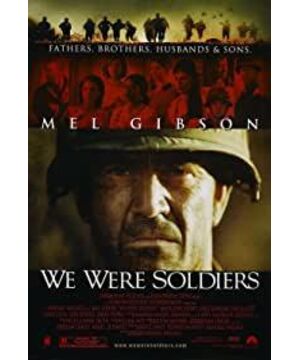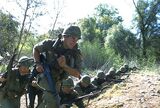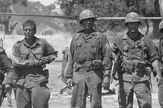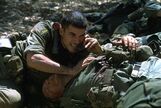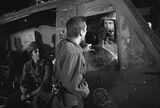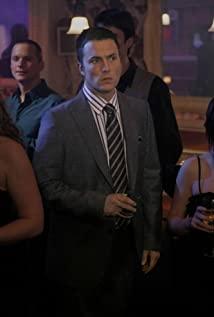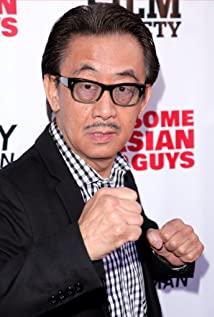"We Were Soldiers Once...and Young" was adapted from a best-selling book called "We Were Soldiers Once...and Young" by Harold Moore, the 1st Battalion Commander of the 7th Cavalry Regiment at the time ( Harold G. Moore and war correspondent Joseph L. Galloway (Joseph L. Galloway) co-authored a detailed record of the battle in the Ia Drang valley in central Vietnam from November 14 to 18, 1965 , And events that occurred after the battle. The two authors not only interviewed many surviving U.S. soldiers and their families, but also went to Vietnam to interview several North Vietnamese People’s Army commanders Zhou Huimin, Huang Feng, Nguyen Youan (all transliterations) and others who had experienced this battle. From the perspective of the US military, but also from the perspective of the Vietnamese army to describe this battle. The name of the original book is meant to commemorate the soldiers who died or are still alive on both sides of the war-"because everyone was a young soldier." At present, the Chinese translation of the book published by Jilin Publishing House in China has been renamed rather ugly, called "A Soldier of the United States" "Vietnam War Experienced", friends who want to find this book should pay attention to the title of this book.
In February 1963, the US Army established an 11th Air Assault Division (experiment) with only 3,000 personnel in Fort Benning, according to the US Army Research and Development Agency’s vision for helicopter cavalry units. Test. In June 1964, the division added two infantry brigades, together with artillery units and other support units, and began training and tactical trials at the battalion, brigade, and division levels. At that time, Harold Moore served as the 23rd Infantry Regiment. 2nd Battalion Commander (Note: The 23rd Infantry Regiment was incorrectly translated as the 23rd Infantry Brigade in the Chinese translation of the Jilin edition. In addition, the battalion had fought the volunteers in Dipingli in 1951.), under the 2nd Infantry Division. In July 1965, the 11th Air Assault Division (Experiment) was officially renamed the 1st (Air Mobility) Cavalry Division, and the 2nd Battalion of the 23rd Infantry Battalion was renamed the 1st Battalion of the 7th Cavalry Regiment. In our words, "This It is a force with a glorious tradition." (When George Custer was the commander of the 7th Cavalry Regiment, the march of the regiment was an Irish drinking song "Gary Irving". In this film, the American soldiers called out "Gary Irving" as they charged. -Owen" is the inheritance of this tradition.) Although the United States has sent military advisers and special forces to intervene in Vietnam’s internal affairs for several years, the United States officially entered Vietnam in 1965. The first head-on fight. At that time, the North Vietnamese generals, after learning that the U.S. troops were stationed in Vietnam, hoped to find out the weaknesses of the U.S. military’s weapons and tactics through a tentative battle. At the same time, the U.S. military was also experimenting with new weapons and helicopter air assault tactics. The North Vietnamese regular army made a head-on confrontation to test the results of these new theories. The 33rd, 66th and 320th Regiment of the Vietnamese People’s Liberation Army under the command of Zhou Huimin and the H-15th Battalion of the Viet Cong guerrillas scattered and hid in the area of Zhu Bang Mountain in the Delang River. The commander of the 1st Cavalry Division did not know the enemy was there. Where, but according to some intelligence, they believe that there may be Vietnamese troops in the Zhubangshan area. On November 14, the 1st Battalion of the 7th Cavalry Regiment descended to the area they named "X-ray" and planned to search for the tracks of the Vietnamese troops. According to the original plan, 16 UH-1 helicopters will go back and forth several times to transport the 450-man unit to the "X-ray" landing area in batches. However, due to the reckless actions of the 2 companies and 2 platoon leaders, the battle was premature. Happened, an ordinary action to find the enemy turned into a siege war, and the North Vietnamese Army had 2, More than 000 people. The 1st Battalion of the 7th Cavalry Regiment did not fight alone. In history, they received more support than in the movie. At 5 pm on the first day of the battle, the 2nd battalion and the 2nd company descended to the "X-ray" area to reinforce the besieged 1st battalion; on the morning of the 3rd day, the 2nd Battalion of the 5th Cavalry Regiment and the rest of the 2nd Battalion of the 7th Cavalry Regiment Arrived in the "X-ray" area on foot, so the 7th Cavalry Regiment 1st Battalion and 2nd Battalion 2nd Company, which had been fighting for 53 hours without rest, took a helicopter back to the station together. Battalion Commander Moore was also the 1st Battalion as promised in the movie. The last person to leave the battlefield. The movie has now ended the battle, but the battle of the Delang Valley in history is not over.
As the US military planned to use B52 to carry out a carpet bombing of Zhubang Mountain, the two battalions left behind were asked to walk to the other two landing areas and take a helicopter to leave. When the 2nd Battalion of the 7th Cavalry Regiment went to the area called "Albany", it encountered the North Vietnamese Army Reserve stationed there. Although it was an unexpected encounter on both sides, it was unprepared and scattered. The 2nd battalion was immediately divided into several small groups and surrounded. With the help of powerful fire support and reinforcements from the US, the besieged US troops were finally rescued on the second day. However, the loss of troops in less than 24 hours of fighting was more than the loss in 3 days of fighting in the "X-ray" zone. many. The screenwriter replaced such a shameful plot with a fictional victory counterattack, but in fact the US military had no idea where the Vietnamese army's base camp was at the time.
But in general, the battle scenes of this movie are very wonderful. Many details are also from the original records, which are still very interesting. The arrangement of the movie props is very careful and conscientious, allowing the audience to return to Vietnam in 1965. On the battlefield. The main weapons of the US military are M16 rifles and M60 general machine guns, as well as M79 grenade launchers and M1911A1 pistols. Someone once accused that the "Thomson" submachine gun appeared in the movie as a piercing shot. In the film, the M1928 "Thomson" submachine gun did appear in the film, and there was also an M1 carbine, but whether it was an M1 carbine or a "Thomson" submachine gun In the early days of the Vietnam War, World War II weapons used to be the main weapons of the South Vietnamese army and US military advisers, and even in the latter part of the Vietnam War, there were still many World War II weapons in use. So this is not a piercing lens at all.
The flame arrester of the M16 rifle in the movie is an early three-petal type, but careful viewers will find that there is an M16A1 auxiliary push handle on the right side of the receiver. Many people know that the M16A1 was officially named in 1967. In fact, As early as 1964, the U.S. Army began to equip XM16E1 rifles with auxiliary push handles. I specifically searched for photos of battles in the "X-ray" area on the Internet, and found that some of the M16 photos did indeed have auxiliary push handles. Other photos are not, and the rifle in the soldier's hand on the cover of the original book is also an XM16E1. So the M16 rifle in the original book includes M16 and XM16E1.
Note that even though Moore wrote in the original book that the victory of this battle was "brought by brave soldiers and M16", the book also recorded the failure of M16 in some battle fragments, and sometimes had to make some The soldiers squatted at the bottom of the foxhole to troubleshoot, while the others continued to fight with the casualties' M16. There is also a small detail about M16. In the movie, Galloway's M16 was handed to him by Sergeant Plomley, but according to the original record, Galloway met the Vietnamese army during an interview in the special forces camp of Polemé earlier. At that time, all the available resources were used in the camp. In order to survive, Galloway also accepted the assignment and participated in the battle. After the battle, the commander of the special forces Charles Bakewes (later became the founder of the Delta Force) He was given an M16, and he came to the "X-ray" area with this M16 on his back.
Perhaps it was for Basil Plumley to create a tough and old-fashioned image. In the film, he is arranged to always use an M1911 pistol (not M1911A1). The line in the film is that he does not trust the M16 plastic pistol. , But this is never mentioned in the original work. Although the M1911 pistol is powerful, after all, the combat distance of the pistol is limited. The plot of this movie is only to shape the personality of Sergeant Major Plomley. However, many M79 grenade or mortarers only have a .45 caliber pistol as their self-defense weapon. In the original work, several US soldiers used .45 pistols to fight North Vietnamese soldiers who broke through the defense line.
In addition, although there are several shooting shots of M60 general-purpose machine guns in the movie, they are far less impressive than the description in the original book. According to the original work, the conscientious M60 machine gun team provided continuous and effective fire support. When they occupied a favorable position, they often prevented the Vietnamese army from approaching the US infantry. However, the machine gun team rarely moved after deployment, so their casualties were also very heavy. .
In the movie, we noticed that there were mortars in the American defensive positions. At that time, each company in the 1st Battalion of the 7th Cavalry Regiment was equipped with a mortar platoon, using M29 light mortars, these 81mm mortars The artillery provided direct support firepower for the trapped US troops, and it also cost a lot of casualties, but there is no record of using urine to cool the barrel in the original work. Although it is not possible to estimate the strength of the enemy in advance, in order to support this attack, Harold Moore had arranged 2 howitzer companies before the departure of the 1st Battalion. A total of 12 M101A1 105mm light howitzers were deployed in Farr. Ken landing area to support the operations of the 1st Battalion. This 2-ton howitzer has an effective range of about 11 kilometers and a general rate of fire of 3 rounds per minute. It is said that experienced gun squads can reach 10 rounds per minute at the fastest. This rate of fire is often achieved. They fired 18,000 shells in 53 hours, burned out several barrels, and burst the rear seat of two guns. They were put back into service after emergency repairs. Although the two artillery companies only have one shot in the movie, Moore’s evaluation of the artillery in the original work is extremely high. It is precisely because these artillerymen built a wall of shells around the besieged US army that more than 400 people were in the field. Many more enemy troops survived continuous siege.
In the Battle of Delang Valley in 1965, the helicopter used by the US military was UH-1D, but the UH-1H that appeared in the movie two years later. In order to increase the load capacity, the H-type is replaced with a more powerful engine, and the difference in appearance between the D-type and the H-type is in the engine compartment. In addition, in 1965, the UH-1D was equipped with an M3 rocket launcher, an M6 machine gun system or an M5 grenade launcher. However, the M21 weapon system that was not available at the time appeared prematurely in the movie, although the M134 machine gun was as early as 1964. It was tried on AC-47 since 1967, but it was not used on helicopters until 1967.
Some people who have not read the original work doubt that the U.S. military has received so much air support. However, according to the original work, after the signal of "broken arrow" was issued, all the combat aircraft that could be deployed in Vietnam at that time were transferred. All types of aircraft were in the air. Line up and attack the targets one by one under the guidance of the advancing air controller on the ground. However, the most impressive thing in the eyes of soldiers on the ground is the A-1E, because this low-speed propeller attack aircraft can slowly fly over their heads and accurately attack the enemy forces that are almost handed over to the US military, and the A-1E and The howitzer company supported the American soldiers from beginning to end, so the American soldiers who were besieged were very grateful to them. In addition, it is a fact that a pair of F-100 fighters mistakenly attacked the battalion headquarters in the movie. If it were not for the air forward controller to call the wingman to stop the bombing in time, the outcome of the battle in the Delang Valley might have to be rewritten. In fact, the forward controllers who guide the air fire support and artillery support have played a huge role in the survival of the besieged American troops, but these radio callers who have given high honors in the original work have become unknown in the movie. Compared with the U.S. Army, the North Vietnamese People’s Army’s weapons and equipment are much shabby. Because they only have infantry melee weapons and lack long-range suppression firepower. Despite their superior numbers and high morale, the U.S. forces have repeatedly attacked them. The artillery support collapsed. Of course, this was also true at the time. According to the memories of the North Vietnamese commander at the time, the three regiments of the North Vietnamese regular army entered southern Vietnam on foot through Cambodia. The lack of transportation and long-distance dialing meant that they could only carry light weapons. Although there were some human trolleys to transport supplies, they were insufficient. To transport too many heavy weapons. Therefore, the weapons used by the North Vietnamese People’s Army are mainly AK-47 assault rifles and SKS semi-automatic rifles. The US forces seized almost the same amount of SKS and AK-47 when cleaning the battlefield. However, in the film, SKS only appeared during the ambush of the 100th French mobile regiment. Most of them are AK-47s when fighting with the US military. At that time, not all AK-47s used by the North Vietnamese Army were produced by the Soviet Union. There were also AK-47s from China and other Eastern European countries. The AK-47 props used in the movie belong to the third type of AK-47 produced after 1953, but it is not clear which country it is.
In addition to the AK-47 and SKS, other weapons that appeared were the Jeggarev DP machine gun and the German MG34 machine gun used in World War II, as well as a DShK anti-aircraft machine gun. The original work mentioned many times that the low-reaching firepower of the North Vietnamese Army’s machine guns often suppressed the U.S. Army’s heads up, but the movie only saw the North Vietnamese Army charging with light weapons. Not only did these machine guns have fewer chances to play, but they also didn’t have the chance to shoot. In addition, it is mentioned in the original work that many Maxim machine guns were seized, and the North Vietnamese Army also had mortar support firepower, but these did not appear in the movie.
Compared with the North Vietnamese People’s Liberation Army, the Viet Cong’s H-15 Battalion’s weapons are more complex. In addition to the AK-47 and SKS, there are also MAT49 submachine guns and Mosin-Nagan rifles. MAT49 is produced in France. This 9mm submachine gun was seized by the Viet League in the hands of the French and was used by Viet Cong guerrillas during the Vietnam War. The Mosin-Nagan rifle not only appeared in the shots of the H-15 Battalion, but also appeared in the opening shots of the 100th French mobile regiment ambushing. In addition, a large number of World War II weapons appeared in that episode, including the Soviet PPSh-41. Submachine gun, PPS-43 submachine gun, Czech ZB26 light machine gun.
Finally, let me mention the light weapons of the French army, mainly the French MAS36 rifle and the American M1919A4 heavy machine gun. In fact, the light weapons used by the French army at that time were indeed very mixed, especially the machine guns, which were left over from the Second World War, including Germany. And American. However, since the footage of the French army only appeared for 1 minute in the movie, and it was easily levelled, so few people paid attention to their weapons. But the fact that the 100th Corps was besieged and annihilated was not an easy job that could be done in half a minute in the movie. However, in the original work, there is no description of how the French army was ambushed, but it was mentioned, and the area surrounded by the United States was not the location where the 100th regiment was ambushed. However, the role of such shooting in the movie is the same as the frequent mention of George Custer in the original work. It also implies that the battalion would have been like the French 100 Corps or the troops of Custer after being surrounded, but in the end it changed its destiny on its own. , Not annihilated like them. The other two battalions have the same fate as the French 100th Corps: they all marched from the same base-Anxi, in the same direction-probably along the 19th strategic road towards Polegu, and the Vietnamese used it against the French. The same means to deal with the US military. However, in this episode of the plot, there was an error of historical research. At that time, there were no paratrooper units of the foreign legion in the French 100th Corps, but the French officer in the movie was wearing a white high-top cap of the foreign legion, and the film The berets of the French army were not the same style used by the French army at that time. The berets used by the French army at that time were basically the same as those used by the British army in World War II, but what appeared in the movie is now used by the US army.
(Special thanks to the information and help provided by the cold fighters )
————————
[This article source: http://firearmsworld.net/other/sportful/wwss/wws.htm ]
[Original title: ""We Used to be Young Soldiers": Looking at Pictures and Talking-Weapon Props in Movies"]
View more about We Were Soldiers reviews


